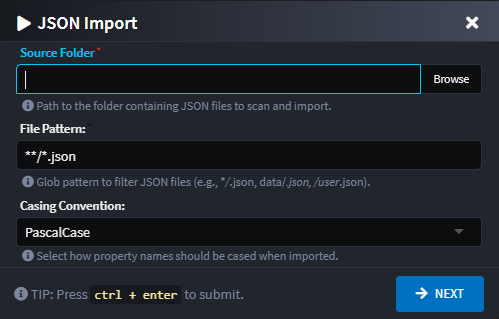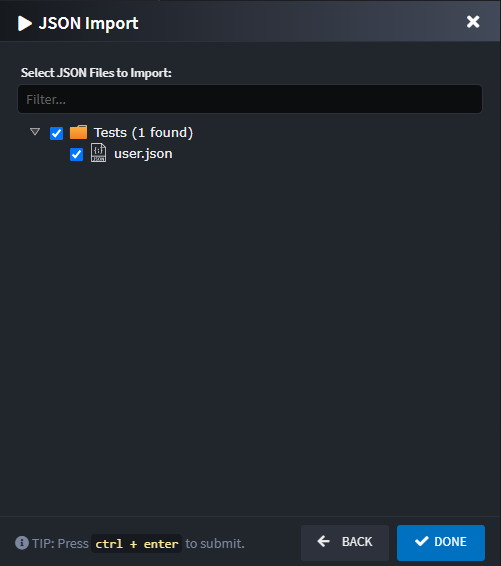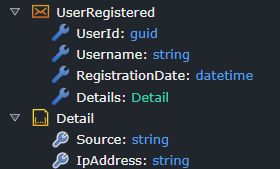Intent.Json.Importer
This module adds to Intent Architect the ability to import metadata from JSON files. For example, importing a set of JSON files to create a domain model.
How it works
The importer is available on specific packages in the designers. Right-click on the package and select the Import from JSON context menu option.
The profile used for the import is determined by the type of package you right-click on:
- Domain Designer: Right-clicking on a
Domain Packageuses theDomainDocumentDBprofile to import the JSON files asEntities. - Services Designer: Right-clicking on an
Eventing Packageuses theEventingMessagesprofile to import the JSON files asMessages.

Selecting this option will provide you with the following dialog:

The wizard has two steps:
1. Configure Source and Import Settings
This screen captures the location of your JSON files and how they should be interpreted.
Source Folder
The root folder where your JSON files are located. The importer will scan this folder and its subdirectories.
File Pattern
A glob pattern to filter which files are considered for import. Defaults to **/*.json.
Examples:
**/*.json: All files with a.jsonextension in the source folder and all subfolders.data/*.json: Only.jsonfiles in thedatasubfolder.**/user*.json: Any.jsonfile starting withuserin any subfolder.
Casing Convention
This setting controls the casing of created elements and their attributes.
- As Is: Uses the casing directly from the JSON file properties.
- PascalCase: Converts element and attribute names to
PascalCase.
2. Select Files to Import
After configuring the source, the next screen allows you to select which of the discovered files you wish to import.
A tree view displays all the files and folders that match the File Pattern from the previous step. You can select individual files or entire folders to be included in the import.
JSON File Structure
The structure of the JSON files depends on the selected Profile.
Note: Each file must contain a single top-level JSON object. Top-level arrays or primitives are not supported.
Type inference rules used by the importer:
- Strings are imported as string unless the value is the sentinel token "guid" or "datetime", which infer Guid and DateTime respectively.
- Numbers are imported as decimal.
- Booleans are imported as bool.
- Null/undefined values are treated as unknown and default to object.
- Arrays infer their element type from the first element; empty arrays default to object[].
- Arrays of arrays are not supported.
DomainDocumentDB Profile
When using the DomainDocumentDB profile, each .json file is treated as a definition for a Entity in the Domain Designer. The filename (without the extension) is used as the name of the Entity. The JSON object's properties are imported as Attributes on that Entity.
Nested JSON objects will be modeled as separate Entities with composite (has-a) relationships between them. Arrays of objects will result in a composite relationship with a many cardinality.
Example user.json:
This file will create a User entity with attributes like id, firstName, lastName, email, and createdAt. It will also create an Address entity and an Order entity and establish composite relationships from the User entity to them. The values "guid" and "datetime" are sentinel tokens used to infer Guid and DateTime types.
{
"id": "guid",
"firstName": "John",
"lastName": "Doe",
"email": "john.doe@example.com",
"createdAt": "datetime",
"address": {
"street": "123 Main St",
"city": "Anytown"
},
"orders": [
{
"orderId": "guid",
"orderDate": "datetime",
"total": 99.99
}
]
}
Diagram representation:

EventingMessages Profile
When using the EventingMessages profile, each .json file is treated as a Message in the Services Designer. The filename (without the extension) is used as the name of the Message. Nested objects are created as Eventing DTOs and linked to the message.
Example user-registered.json:
This file will create a UserRegistered message with userId, username, and registrationDate properties. It will also create a RegistrationDetails DTO with a source property and associate it with the message. The values "guid" and "datetime" are sentinel tokens used to infer Guid and DateTime types.
{
"userId": "guid",
"username": "john.doe",
"registrationDate": "datetime",
"details": {
"source": "WebApp",
"ipAddress": "192.168.1.100"
}
}
Tree-view representation:
